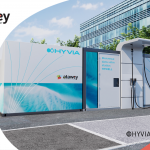
Hydrogen Colours and Refuelling Stations: Between Myths and Realities
Dihydrogen (H₂) — the Molecule of two hydrogen atoms, commonly known as hydrogen — is produced by various methods. Despite being colourless and odourless, hydrogen is adorned with different colours in the energy sector.
Let’s take a closer look at a palette ranging from black to white, including green hydrogen.
The Evolution of Hydrogen Colours in Line with Production Methods
What Are the 12 Colours of Hydrogen?
Hydrogen is categorised by twelve well-defined colours, sometimes with subtle variations:
Brown / Black
Grey
Blue, Turquoise
Pink, Red, Violet, Yellow
Green
White, Orange
Each colour corresponds to the production method or the energy source used. These processes have evolved over the years, increasingly favouring environmentally friendly methods.
Black, Brown, and Grey Hydrogen: Legacies of the Fossil Fuel Industry
Black and Brown Hydrogen are produced by gasification of bituminous coal (black hydrogen) and lignite (brown hydrogen). This process is highly polluting, releasing CO₂ and carbon monoxide into the atmosphere.
Grey Hydrogen is produced from fossil fuels, primarily via steam methane reforming (SMR). It is currently the most common form of hydrogen due to its lower production costs. However, this process emits roughly 10 tonnes of CO₂ per tonne of hydrogen produced. Although less polluting than coal gasification, it still contributes significantly to CO₂ emissions.
Blue and Turquoise Hydrogen: Early Steps Toward Lower Emissions
Blue Hydrogen is derived from grey hydrogen but involves capturing and storing most of the CO₂ produced, typically underground. Despite this, 10 to 20% of CO₂ emissions remain uncaptured, and methane leaks during production have been noted, so blue hydrogen is often considered a carbon-intensive form.
Turquoise Hydrogen is produced by methane pyrolysis, which heats methane to very high temperatures, producing solid carbon used in products like tires, plastics, and batteries. This method uses natural gas as feedstock, and if the energy for the process is renewable, the overall carbon footprint is close to neutral.
Red, Pink, Violet, Yellow Hydrogen: The Pursuit of Low-Carbon Energy
Pink hydrogen is produced by electrolysis using electricity from nuclear plants.
Red hydrogen results from high-temperature catalytic splitting of water, with chemical reagents recycled in a closed-loop system.
Violet hydrogen is produced by nuclear-powered thermochemical water splitting combining heat and electrolysis.
Pink, Red, and Violet Hydrogen are generated through water splitting powered by nuclear energy:
Yellow Hydrogen, also produced by electrolysis, comes from an energy mix with a significant nuclear component.
Green Hydrogen: The Promise of Clean Energy
Green Hydrogen typically refers to hydrogen produced from electricity generated by renewable sources such as solar or wind power. It can also include hydrogen made from other renewables like biogas, biomethane, or organic waste. Currently, the most common green hydrogen production method is water electrolysis.
No CO₂ emissions are associated with green hydrogen production or use. When used in fuel cells, the only by-product is pure water—the same water initially used in production.
White and Orange Hydrogen: The New Frontier?
White Hydrogen refers to naturally occurring hydrogen found deep within the Earth’s crust, requiring no production process. Its extraction resembles natural gas drilling, tapping into natural hydrogen wells. One of the most famous sources is the Bourakébougou village in Mali, where a well has emitted gas containing over 97% hydrogen for more than 30 years. Recently, a similar deposit was discovered in Moselle, France.
Orange Hydrogen is produced by injecting saltwater into iron-rich rocks, triggering chemical reactions that release hydrogen.
Hydrogen Colours: From Black to White
These varied colours reflect the evolution of hydrogen production methods toward cleaner, more environmentally friendly energy sources. Green hydrogen stands out as a promising solution for a sustainable energy future and a key enabler of decarbonised mobility. Its production depends on renewable energy availability, necessitating attention to technology development timelines.
Green Hydrogen and Refuelling Stations: Current Status
There are two ways to supply a hydrogen station:
- On-site Electrolyser: The colour of hydrogen depends on the country’s energy mix where the station is located and is green if supplied by renewable electricity.
- Hydrogen Delivered via Compressed Tube Trailers: The hydrogen colour depends on the production method, country of origin, and transportation mode.
There are also projects involving central hydrogen production stations supplying satellite stations with electrolytically produced hydrogen.
At Atawey, compact stations can integrate an electrolyser.
Conclusion
The various hydrogen colours embody the evolution of production methods toward more environmentally responsible energy. There is a growing necessity to develop low-carbon and decarbonised hydrogen production solutions.
As societies mobilise to reduce their carbon footprint and adopt cleaner energy sources, the demand for green hydrogen currently exceeds supply. This is partly why green hydrogen costs more than grey hydrogen.
Investment in time and funding is therefore crucial for developing production technologies and will be decisive in the coming years.





